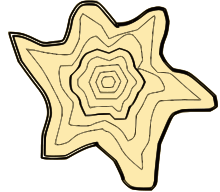Backward tension
In tree trunks, tension backwardness describes the phenomenon that the trunk does not have a circular, but an irregular cross-section. The cross-section is characterized by deep furrows and ridges. It often occurs in the root approach of older trees. If it pulls itself up into the trunk, it is considered a wood fault . It occurs particularly frequently in hornbeam , yew , crab apple and juniper , and to a lesser extent in gray alder .
Tension backwardness is caused by irregular secondary growth in thickness , which in turn is caused by inadequate nutrition of the cambium .
literature
- Helmuth Neuhaus: Timber engineering. 2nd Edition. Vieweg + Teubner Verlag, Wiesbaden 2009, ISBN 978-3-519-15248-4 .
- HH Bosshard: Wood science. Volume 3, aspects of woodworking and wood utilization, Springer Basel AG, Basel 1975, ISBN 978-3-0348-5204-3 .
- Bernd Wittchen, Elmar Josten, Thomas Reiche: wood specialist. A teaching, learning and work book for carpenters / joiners and wood technicians, 4th edition, BG Teubner Verlag, Wiesbaden 2006, ISBN 978-3-519-35911-1 .
Individual evidence
- ^ A b Gerhard Stinglwagner, Ilse Haseder, Reinhold Erlbeck: The cosmos forest and forest lexicon . 4th edition. Franckh-Kosmos, Stuttgart 2009, p. 793. ISBN 3-440-12160-7 .
Web links
- Forest use (accessed on August 9, 2018)
